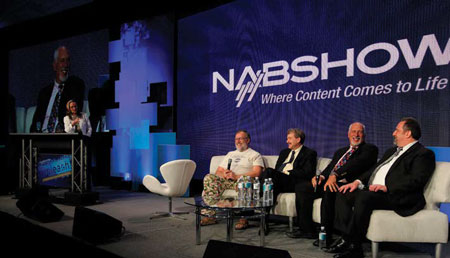UHD is About More Than Just Pixels
BOSTON—I had the pleasure of being part of the 2016 NAB Show Super Session “4K, UHD, HDR and More: The Future of Video.” In a very large conference room completely full of attendees, my co-panelists and I—under the astute direction of TV Technology’s Deborah McAdams—talked about a variety of Ultra High Definition (UHD) related topics, describing the state of the industry with regard to UHD as well as opining about what we thought were the important issues to tackle and where we thought the industry was heading.

(L to R): Deborah McAdams, Mark Schubin, Robert Seidel, James DeFilippis and Matthew Goldman
“Ultra HD,” of course, means much more than just higher spatial resolution (4K and 8K), even though that is to what many in the industry and consumers equate it. It includes four other image as well as immersive audio technologies. The four other image technologies are high dynamic range (HDR), wide color gamut (WCG), deeper sample bit depth (higher number of coefficient bits for the digital samples), and high frame rate (HFR). All of these technologies combined create a much more realistic and immersive TV viewing experience than today’s conventional HDTV, without requiring any special head gear (such as that required for the near-totally immersive virtual reality techniques that are also a new exciting area of discussion).
BANDWIDTH CONSTRAINTS
As is typical, pre-produced content is ahead of live TV broadcasting for delivering UHD, with Ultra HD Blu-ray discs and some on-demand or over-the-top services already providing both 4K and HDR. This should not be a surprise: it’s much easier to implement new services when one controls both ends of the ecosystem, with only a passive delivery pipe in between. All post-production is done in advance, with the receiver/player/rendering/etc. acting on the content, unchanged by the delivery mechanism, whether via wire, wireless or “sneaker net.” With live TV broadcasting, there is no advanced post-production; all is done in real-time. Live changes (such as logo insertion, lower thirds, graphic overlays, picture-in-graphics, squeeze & tease, cross-fades for interstitials, or country-specific format conversions, etc.) could occur at each “node” along the live broadcast chain. Another major factor is available bandwidth; there simply may not be sufficient bandwidth to delivery UHD services, especially for the technologies that require a lot more bandwidth than today’s conventional HD services do. Lastly, there may be regulatory restrictions impacting new services over certain networks, such as over-the-air broadcasting, that prevent economically-viable transmission of UHD services.
As previously mentioned, all of the five image technologies combine to give a much more compelling visual user experience than today’s conventional HDTV, so if a content/service provider is able to offer a UHD service that includes all five, then fantastic. Definitely offer this compelling, much more realistic TV viewing experience. Consumers will be thrilled.
However, what if bandwidth constraints prevent the content/service provider from offering “full UHD,” so to speak? Should the provider just resign itself to continue with today’s conventional HD service? Absolutely not. The combination of HDR + WCG + 10-bit sample depth (which many of us refer to as “HDR+”) has been shown in numerous demonstrations to have fantastic “wow” factor for consumers. And the good news is, depending upon the HDR+ scheme chosen, the bandwidth increase over conventional TV (what’s now referred to as standard dynamic range + narrow color gamut + 8-bit depth) is minimal, in the general range of zero-20 percent when using the new HEVC video compression at direct-to-consumer bitrates… most definitely the Best Bang for the Bit. Compare this to 4K resolution: Even with the best video compression available today (HEVC), 4K resolution still requires somewhere around 250 percent the bandwidth of conventional HD (also coded using HEVC, for apples-apples comparison). And since the “bread and butter” of revenue still will be the conventional HD service, this bandwidth requirement most likely will be in addition to the existing service (that is, simulcast will be required).
IS 4K NEEDED? WHY NOT 1080P?
So in the case of bandwidth constraints, why not transmit in 1080p HDR+ and achieve the “wow” factor of HDR+? All 4K TVs upconvert 1080p to 2160p (4K) and the newer UHDTVs (4K + HDR+) will display an HDR+ image if the incoming stream has HDR+ coded, regardless of the spatial resolution. Many consumers may not even realize that the image was upconverted to 4K: An oft under-discussed issue is that the proper viewing distance for the human visual system to resolve 4K resolution is approximately 1.5x the picture height of a 16:9 display, whereas HD resolution can be resolved in full as far back as 3x the picture height. In most TV viewing environments today, consumers are sitting back from the display about 2.5-3.5x the picture height, therefore not really “seeing” much difference between HD and 4K.
Ericsson has done “unscientific” experiments at trade shows over the past two years, with two equal size flat screens side-by-side and we asked attendees which image they preferred (without telling them what they were looking at). Almost 100 percent would select the 1080p HDR display over the 2160p SDR display (and this was done at the proper viewing distance). This unscientific experiment is just one of many that have shown the “wow” factor of HDR+ to consumers, regardless of screen resolution.
So what about HFR? Like 4K resolution, HFR requires lots of changes in the studio and post production facilities. Its impact is also related to how fast or complex the scene motion is, so it’s extremely useful for high motion sports and nature documentaries, but doesn’t do anything much at all for “talking heads” and other low motion content. While there are examples of specialty content being shot at HFR—for video, this is defined as anything higher than 50 or 60 fps (country TV-standard specific), but it typically refers to 100 or 120 fps today—wider use of HFR likely will not occur for several more years to come, so it is not so big an issue for today.
In summary, if a provider is able to offer a UHD service that contains all of the five image technologies than definitely do it. This is just so much better than today’s conventional HD. However, if bandwidth constraints prevent “full UHD” from being delivered, the Best Bang for the Bit is definitely 1080p HDR+… with much of the “wow” factor and a far superior user experience over today’s conventional HD.
Matthew Goldman is the senior vice president of Technology, TV & Media Strategy for Ericsson.
Get the TV Tech Newsletter
The professional video industry's #1 source for news, trends and product and tech information. Sign up below.

